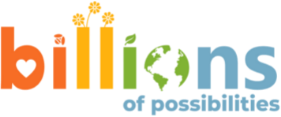by Rebecca Margiotta | May 23, 2018 | Becky Update
I turned 49 years old last week which prompted a fair amount of reflecting on my purpose and what I most want to contribute in my remaining years on the planet. As we teach folks how to do in the Skid Row School, I have re-committed to what I am here to do: support large-scale change leaders in bringing their fullest, biggest, most badass selves forth to create massive transformation on our planet.
You know, no big whoop.
I am a woman on a mission and will continue to tweak the Billions Institute to be even more fully aligned with my purpose in the months and years ahead.
There are over 1,000 people on the Billions Institute mailing list. I’m so glad you are here and hope you will stay. I haven’t written to you much in the past mostly because I didn’t want to bother you.
And yet, I have so much I want to share with you.
Starting today, I will be offering my thoughts to you on a weekly basis.
Even though I teach about the science of large-scale change, I, too, am on this journey with you. I love the human connection that is a natural consequence of authenticity. Therefore, I will not be holding anything back or packaging what I share to be “appropriate.” I’m sure it will even get messy from time to time, but that’s how we learn.
Not to mention I believe those of us who are weaving together the web of life need one another’s presence now more than ever. I truly believe that friends don’t let friends lead large-scale change alone.
If you want a weekly “Becky raw and unfiltered” e-mail with practical pointers about the science of large-scale change plus a healthy dose of personal development, stay tuned. Meanwhile, you can get a bit of a sneak peak about my latest and greatest thinking here.
If that does not appeal to you, unsubscribe now and I promise there will be no hard feelings.
Great big hug to each and every one of you (except the non-huggers),
Becky
p.s. In case you missed it, check out our latest blog on Skid Row School alumni Elizabeth Cushing: a force to be reckoned with, bringing safe and healthy play to an elementary school near you!
pps. Check out my birthday present! We commissioned LA artist Colette Miller to transfer to a “step and repeat” one of her famous Angel Wing paintings that she first did on Skid Row but now they are all over the world. We’ll bring this beautiful piece of art to all future Skid Row Schools for participants to take a #spreadyourwings selfie! We unveiled this with our fellows at my little birthday gathering and wanted to share with you these beautiful, radiant human beings. In order of appearance, behold Maša Uzicanin (up top), Katie Hong, Eunice Nichols, Alison Marczuk, Michelle Molitor, Jennifer LeSar, Lindsay Hill, Brigid Ahern, and Dr. Elizabeth Kelly.


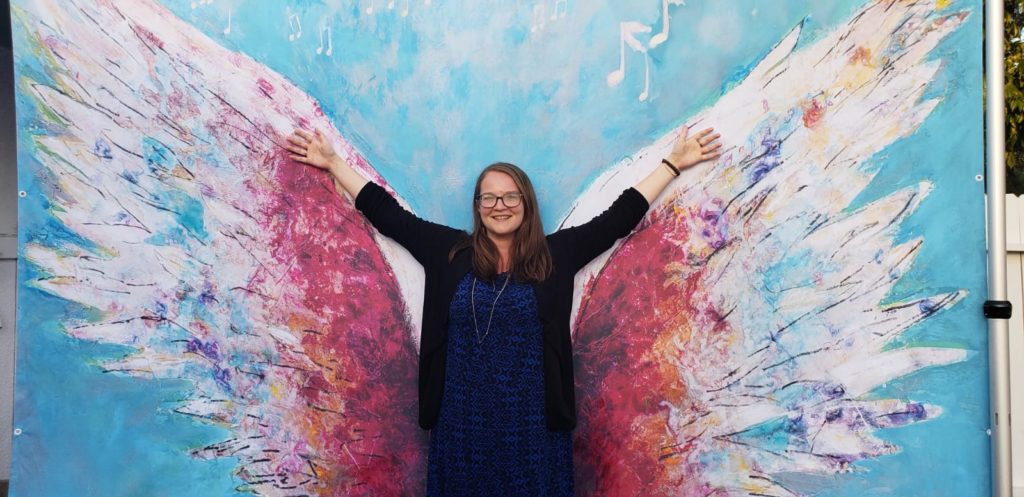





We have a few more openings for the July 10th – 13th and October 23rd – 26th sessions of the Skid Row School.
Remember: if you are an alumni and you want to bring back your team back with you as a strategic retreat of sorts, you can come back for free (your team still has to pay but you’re free!) Just use the code “alumni” when you apply for a group ticket and we’ll take care of the rest.
by Rebecca Margiotta | Apr 19, 2018 | Alumni Profiles
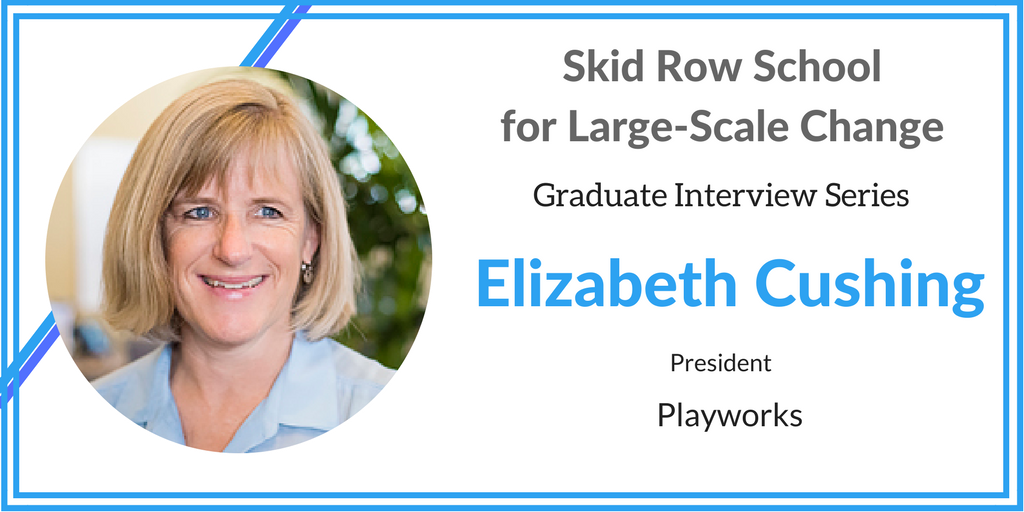
Meet Elizabeth Cushing. Elizabeth is President of Playworks. As president, Elizabeth leads the senior management team and is responsible for ensuring that all strategic targets are met across the organization.
What is the core/heart of Playworks’ intervention?
Playworks taps children’s intrinsic motivation to play in order to teach them valuable social and emotional skills like cooperation, respect, and resolving conflict. So it sounds very simple, but by paying attention to how kids learn through play we are able to transform their experience of school and the school climate as a whole. We are increasing student engagement and physical activity while decreasing bullying, all with a minimal investment. We want to transform schools from a place where kids are not sure they want to be to a place where they want to be.
We like to quote Don Berwick “Some is not a number, soon is not a time.” What is your current 18 to 36 month aim?
Our aim is that by December 2020, 3.5 million children in 7,000 elementary schools will experience safe and healthy school everyday. What’s significant is that our aim does not say “Playworks.” We recognize that our vision is about play and not about our organization. Stating that emphatically in the aim inspires us to be creative about other partners and channels for making that play happen. Other organizations can benefit from taking this perspective. Ask yourself, what social good you want to achieve for society and who else could be a partner in that work that is outside of our organization?
What were the most important take-aways for you from the Skid Row School for Large-Scale Change?
There are two. The first was the idea of unleashing. If you think broadly about who cares about kids being able to cooperate with each other or kids being active or feeling good at school, there are a lot of stakeholders and influencers that might be able to join us in this work. So, it really is about taking us out of the silo of our own organization and truly unleashing others to contribute to more play happening. We are currently working on a set of public statements or principles that make our vision concrete so that others have a clear idea for what they can do to help more children get to play every day.
The second take away was that it’s not important to know the precise strategies you’re going to use to scale. It’s more important to try things quickly, learn from them, and then go back and and try new things based on your learning. I particularly took in the bright spot strategy and the focus on capturing data on small experiments to learn. We have incorporated those practices into our daily operations, which has produced a concrete approach to innovation.
What advice would you give a new leader who really wants to spread/scale their work?
I would say to really do reflections with your leadership, board, and stakeholders about what you’re trying to achieve that transcends your own organization’s existence. Large-scale social change isn’t worth it to grow an organization. It’s only worth it if you’re changing the world beyond what you actually control. And, that mindset shift is powerful if it influences your daily decisions. At Playworks, we ask ourselves every day how does each decision we’re considering get us to our aim. We are trying to be disciplined about not doing things that don’t get us to the aim. It’s an operational mindset. You need real clarity of what you’re trying to achieve.
What gets you motivated and out of bed every morning?
I’m really motivated by the 3.5 million kids. A lot of these kids are not having the experience of school that they deserve. If we can figure this out, then they will. Having seen the power of play that can change a child’s day to day experience, I want to make that happen for the 3.5million.
How do you recharge your batteries and take care of yourself?
- Spending time doing things that feed me like tennis, gardening, and baking.
- Sharing my experience with others who are similarly trying to change the world. The camaraderie of sharing the breakthrough moments recharges me. I found that through connections we made through Billions Institute that other organizations are working through the same challenges, and it’s energizing working with them. I appreciate building relationships with those who are trying to do the same thing.
If you had three wishes for humanity and the planet, what would they be?
- Everyone would act from a place of kindness. That would change the world!
- If we made decisions based on the impact on children all over the world, our decisions would be different. I would love it if we made decisions based on what’s good for kids.
- Recognize the daily opportunities to do good. That’s all we can do – right actions everyday and to have faith that those right actions matter.
by Rebecca Margiotta | Nov 16, 2017 | Alumni Profiles
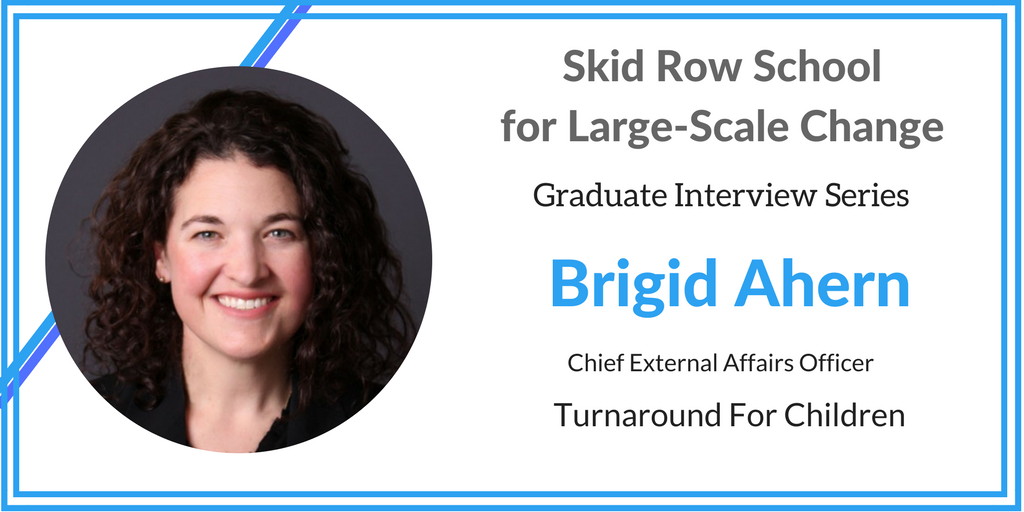
Meet Brigid Ahern. Brigid is the Chief External Affairs Officer for Turnaround for Children. She oversees the Communications, Development, Policy and Systemic Impact teams and serves as the driving force behind efforts to increase stakeholder engagement to fulfill the organization’s mission of transforming high-poverty schools.
What is the core/heart of Turnaround for Children’s intervention?
The heart of Turnaround’s intervention is the deep belief in the potential in every child. Our vision is for every student to attend a school that puts them on a path to the life they choose. The core of our intervention is the translation of science to practice.
Science tells us so much about how children develop as learners, the impact of adversity on that development, and about the power of context – of environment and relationships – to shape children’s development. Turnaround is a leader in translating this science into practice – so much of the science is locked in academia, and we’re trying to change that. We partner with schools and districts to diagnose their school environments and implement tools and strategies that accelerate student development and academic achievement, in ways that integrate with their vision and goals.
We like to quote Don Berwick “Some is not a number, soon is not a time.” What is your current 18 to 36 month aim?
I’m laughing because this quote is on my wall at work, but our 18-36 month aim is very much in development. The truth is that our original aim did not take into account the integrated nature of our intervention nor was it appropriately “chunked.”
Our current aim for the next three years is to increase the number of schools in this country that acknowledge and address the impact of adversity through an integrated approach. Where we struggle is that our goal was a very small number of schools. We are learning that our impact is having far-reaching effects, which are very hard to measure. We have had to change the number of schools, but that number depends on how integrated our programs have to be in order to “count.”
We know that by the end of the 2019-20 school year, we want to build a pipeline of 8 – 10 districts, CMOs (Charter Management Organization), or other organizations who have acknowledged the impact of adversity on learning and want to work with us to address it. Even if we only ultimately work with one or two, getting to this stage means we would have built enough awareness about the impact of adversity and the science of learning that more than 100 schools would be taking action to address it because of our efforts.
What was the most important take-away for you from the Skid Row School for Large-Scale Change?
There were several takeaways. The first is that you have to be creative and flexible, but you don’t have to make all of this up from scratch. Also, that the method helps you put one foot in front of the other and ask the right questions. I was also struck at how incredibly different the organizations that were in attendance, but how applicable the THINKING was from one to the other. I remember sitting with Kate Hurley (Founder of the Million Cat Challenge) at one point and thinking, “our aims could not be more different” and ultimately we were struggling with the exact same issue. It was fascinating just how transferable the work was from one context to the other.
Lastly, I learned how crystal clear you have to be in WHAT you are scaling in order to scale it. It sounds ridiculously obvious, but it’s really hard to do. There is so much possibility and applicability for the work that we do that it’s hard to not get excited about all the places you could leverage the science of learning and development. You have to know exactly what change you want to make in order to pick the right channels.
What advice would you give a new leader who really wants to spread/scale their work?
Be as clear as you possibly can about what you want to be different in the world and continually clarify it. As the leader, you’re the one who sees it clearest. Everyone around you is going to tell you all of these different things, but you have to have the picture of what you want in your head. You are the owner of this new reality. Everyone else has something to offer you to get you there, but at the beginning you are likely the one who sees it the clearest. I can see a world where the potential of each student is seen, valued, and given what they need to succeed. Now we just have to organize ourselves to get to that place.
What gets you motivated and out of bed every morning?
My family. I have 4 year old twins, and their potential is limitless. They speak more languages than I do, tell jokes, and are just these complex tender beings that are sponges. It’s a constant reminder that every single child on earth has that kind of potential if we adults – not just parents, but teachers, principals, school support staff, afterschool leaders – get it right. There is nothing more important..
How do you recharge your batteries and take care of yourself?
I wish I did a better job of this. Having kids and a job like this has made me hypered-scheduled, so when my husband and I have time together, we try not to plan it. We never plan our nights out. We just start out the front door and walk. We’ve walked all over the five boroughs and just talk. We don’t do it as often as we like, but it’s a release from the hyper-planning of every minute. I also love to read fiction and try to do it every single night. Stories are the super highway to the heart.
If you had three wishes for humanity and the planet, what would they be?
Working for Turnaround has helped me crystallize this. It’s about cherishing both the individual people and the context in which they thrive. For an individual, what I mean is that each individual is important and has something to offer, and we must start with kindness, compassion and respect and build toward peace. I have never been more convinced that the key to everything is relationships. What I mean by context is two things: the actual planet –clean water, clean air – and the systems that support humanity –education, medical care, government –to be built to care for individuals. We have learned so much about this relationship between the individual and his or her environment –and each day we learn more about how to make systems that work for all of us. We need to continue to learn, but more than anything we need to get to work.
by Rebecca Margiotta | Sep 27, 2017 | Uncategorized
Please join me in congratulating the magnificent leaders in the inaugural cohort of the Billions Institute Fellowship for Leading Large-Scale Change! These leaders are spreading solutions to racial inequity, infant mortality, illiteracy, housing insecurity, youth homelessness, gun violence, childhood trauma, ageism, and last but certainly not least, math anxiety. Their work is bold, inspiring and at the forefront of advancing social justice and social change. We feel very honored to be alongside them on their journey.
Going forward, we will be doing deep dives together to grow our confidence in leading for racial equity and social justice, communicating authentically in a way that motivates others, and exploring some of the “many ways to many” that we just touch upon at the Skid Row School. The fellows will meet three times a year for two years, each February, May, and September. We will allow new fellows to join the fellowship on a rolling admissions basis starting when we meet again next May 15th – 17th. We’re currently accepting applications for leaders to join the two-year fellowship starting in May 2018.
by Rebecca Margiotta | Aug 10, 2017 | Alumni Profiles
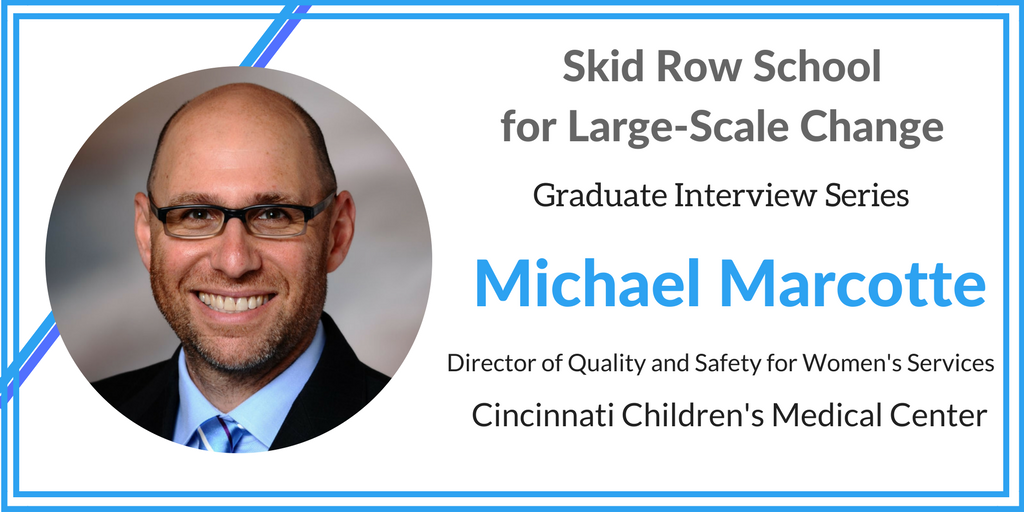
Meet Michael Marcotte. Michael is a maternal fetal medicine specialist in one of the largest Maternity Centers in Ohio–TriHealth as well as the medical director for the HOPE (Helping Opiate addicted Pregnant women Evolve) at Good Samaritan Hospital in Cincinnati.
What is the core/heart of Cincinnati Children’s Hospital’s intervention?
Our intervention is to try to eliminate infant mortality in Cincinnati. Infant immortality is the death of a child from the time of birth up to one year of life. We are trying to eliminate those deaths within that timeframe.
We like to quote Don Berwick “Some is not a number, soon is not a time.” What is your current 18 to 36 month aim?
Our aim is to reduce the infant mortality rate in Hamilton County, Ohio from 9.5 (per thousand) to the national infant mortality rate to 5.9 (per thousand) by December 31, 2020. That translates into 31 fewer infant deaths per year. However, since returning from Skid Row School we’ve thought about changing our aim to be more focused on measuring the transformation of care.
What was the most important take-away for you from the Skid Row School for Large-Scale Change?
The most important take-away from Skid Row School was that I came to the realization that we needed to provide meaningful feedback to the people that we’re trying to help. Primarily, we’re talking about the health care workers and the families who receive care in our 20 different OBGYN centers. For our particular project, we haven’t been giving these groups their data in regards to infant deaths. Dan Heath shared with us that we’ve got to provide them with their data so that they know that a child died that they were caring for. The feedback part was the most eye-opening.
What advice would you give a new leader who really wants to spread/scale their work?
I’d tell them to really be clear about what’s in their control and focus building a team around the moveable/changeable parts that they believe are the key drivers to successfully get to the aim.
What gets you motivated and out of bed every morning?
The desire to create a system in which there can be deep connection for both the people I work with and also the patient and families that we’re interacting with. That became clear to me when I told my Story of Self at Skid Row School. It became even clearer when I told my Story of Self when I returned home. I’m now committed to transforming our system so that it’s a place where deep connection can happen. And, I believe that is the most important key driver in all of the work I do.
How do you recharge your batteries and take care of yourself?
I have a daily meditation practice which is really important to me. It’s like my personal spirituality. And, I also have an amazing family – my wife and daughter are supportive, and I can talk with them about anything. In the past, I’ve done more yoga and more forms of exercise.
If you had three wishes for humanity and the planet, what would they be?
- Each person has at least one deep connection with another human being.
- That everyone who is suffering has someone to accompany them.
- When someone has a deep connection and is accompanied by another human being when they’re suffering, it will transform their view of what is important in their lifetime.








